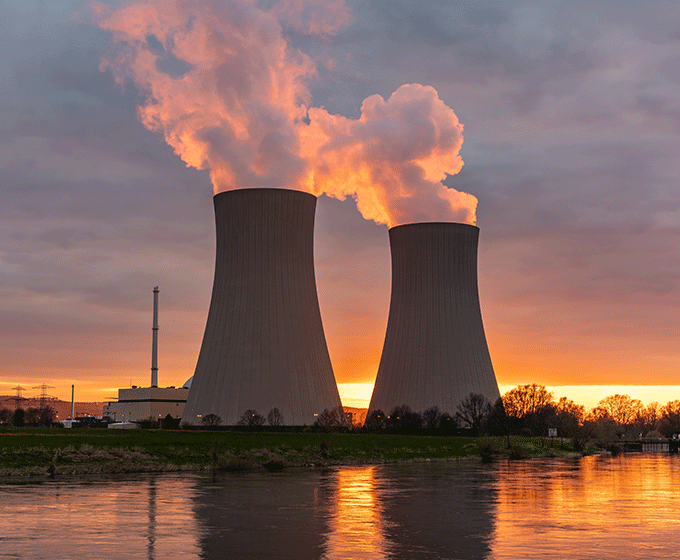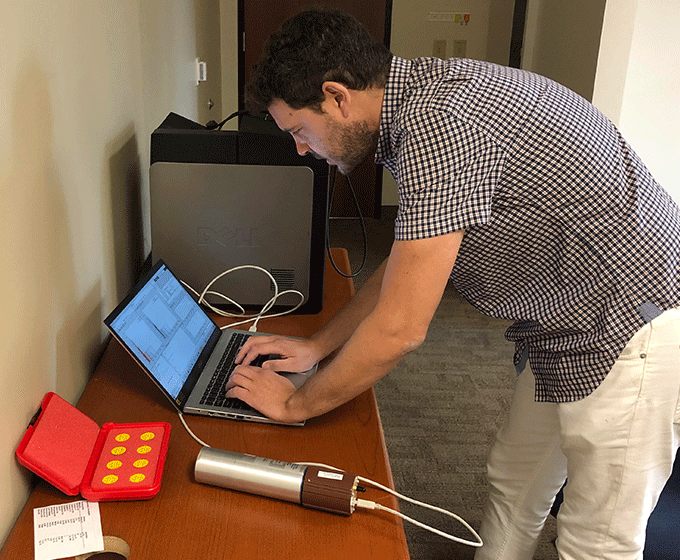
JULY 8, 2024 — UTSA has joined one of two newly established university consortia committed to nuclear security and nonproliferation. The consortia were awarded $50 million in cooperative agreements by the Office of Defense Nuclear Nonproliferation in the U.S. Department of Energy’s National Nuclear Security Administration (DOE NNSA).
“The pressing challenges of nuclear security and nonproliferation require a concerted effort from experts across the country,” said JoAnn Browning, UTSA interim vice president for research. “We’re thrilled to join this collaborative network of universities and national labs, and I look forward to seeing the impact of our researchers as they leverage AI to make nuclear energy more secure, protecting the integrity of the U.S. nuclear stockpile as well as the collective impact of the broader consortium.”
The consortia were established to facilitate collaboration between university and laboratory researchers to advance science and technology that furthers NNSA's nuclear security and nonproliferation missions, “enabling an effective pipeline of talented next-generation experts to establish careers at DOE national laboratories.” Each consortium will receive up to $5 million per year for five years to further these objectives.
 Miltos Alamaniotis
Miltos AlamaniotisUTSA’s participation will be led by Miltos Alamaniotis, GreenStar Endowed Fellow in Energy and associate professor of electrical and computer engineering. Alamaniotis is an expert in applied artificial Intelligence within the nuclear engineering domain.
This marks the second NNSA consortium that UTSA will participate in to advance nuclear science. In 2019, NNSA provided $3 million for CONNECT (The CONsortium on Nuclear sECurity Technologies), a project engaging investigators from the University of Nevada at Las Vegas, St. Mary’s University, Argonne National Laboratory and Los Alamos National Laboratory.
CONNECT has since been renewed for another $5 million in funding, for a total of $8 million from the NNSA.
“The exceptional researchers at UTSA are critical partners in this collaboration,” said Eric Brey, dean of the Klesse College of Engineering and Integrated Design at UTSA. “UTSA is home to world-class researchers and innovators in the nuclear fields. Connecting with our peer institutions and national labs will catalyze our scientific advancements and enhance our students’ experience in this field.”
Alamaniotis is also confident that membership in the consortium will benefit researchers and students.
“This consortium will be an eye-opener for our students, as they will have the chance to interact and collaborate with students from top schools across U.S., while performing high-quality research in a critical field of national and international interest,” he said. “Furthermore, in a consortium of this large scale our students will have the chance to prove themselves and showcase the qualities and capabilities of UTSA.”
 Alamaniotis at the Laboratory for Applied Artificial Intelligence
Alamaniotis at the Laboratory for Applied Artificial IntelligenceAlamaniotis is a co-principal investigator in the consortium and the principal investigator (PI) representing UTSA, where he leads research efforts and prepares students for careers in the nuclear enterprise.
Each PI in the consortium is responsible for contributing to collaborative research as well as leading one research project of their own. Alamaniotis will lead a project that “focuses on developing artificial intelligence algorithms to coordinate the movement of multiple mobile detectors within a metropolitan area to identify hidden radiological threats,” he said.
“This project is particularly challenging due to the presence of naturally occurring ambient radiation and the uncertainty regarding the type of threat,” added Alamaniotis. “Anyone in possession of illicit nuclear material is a threat to our safety. We want to prevent detonation and dispersion of radioactive material within metropolitan areas, and there is only way to accomplish this: detect the material while on the move before it is detonated. We also need to retain privacy in data analysis, as we cannot allow mistakes and wrongly accuse people as potential terrorists. This can only be attained by developing highly sophisticated AI algorithms fed with high-quality datasets.”
The two consortia that are receiving funding from the U.S. Department of Energy will be led by the University of Tennessee, Knoxville and Georgia Institute of Technology respectively.
They include:
This consortium comprises 15 universities and eight national laboratories, including UTSA, the Colorado School of Mines, the Air Force Institute of Technology, Clemson, UC Santa Barbara, University of Hawaiʻi, Louisiana State, MIT, North Carolina State, University of Oklahoma, Oregon State, Texas A&M, University of Utah, Virginia Tech, Idaho National Laboratory, Lawrence Berkeley National Laboratory, Lawrence Livermore National Laboratory, Los Alamos National Laboratory, Oak Ridge National Laboratory, Pacific Northwest National Laboratory, Sandia National Laboratories and Savannah River National Laboratory.
This consortium comprises 12 universities in partnership with 12 national laboratories, including Abilene Christian, Colorado School of Mines, MIT, The Ohio State University, Rensselaer Polytechnic Institute, Stony Brook University, Texas A&M, University of Alaska Fairbanks, UT-Austin, University of Wisconsin - Madison, Virginia Commonwealth, Argonne National Laboratory, Brookhaven National Laboratory, Idaho National Laboratory, Lawrence Berkeley National Laboratory, Lawrence Livermore National Laboratory, Los Alamos National Laboratory, Nevada National Security Site, Oak Ridge National Laboratory, Pacific Northwest National Laboratory, Princeton Plasma Physics Laboratory, Sandia National Laboratories and Savannah River National Laboratory.
The formation of the consortia began in November 2023, when the NNSA released a call for proposals. Interested schools extended invitations to potential collaborators. The University of Tennessee, Knoxville took the initiative to lead the proposal for the consortium that includes UTSA. It identified target research areas and invited individuals, including Alamaniotis, to participate. The NNSA conducted the final selection process, which was highly competitive.
UTSA has a growing number of academic and research opportunities in the broader area of security and cybersecurity. It boasts several centers and institutes devoted to security, including the National Security Collaboration Center, the Cybersecurity Manufacturing Innovation Institute, the Center for Infrastructure Assurance and Security, the Institute for Cyber Security, the Cyber Center for Security and Analytics, as well as the NSF CREST Center for Security and Privacy Enhanced Cloud Computing. UTSA is also one of a select few universities to hold all three NSA designations for centers in academic excellence in: Cyber Defense Education, Cyber Research and Cyber Operations. UTSA offers undergraduate, graduate, and doctoral programs with a focus on cybersecurity.
“Our school is renowned for its cybersecurity programs,” added Alamaniotis. “This initiative will establish a new line of research in security, broadening the scope of security research at UTSA in a domain of the utmost importance for our society and future energy sustainability.”
UTSA Today is produced by University Communications and Marketing, the official news source of The University of Texas at San Antonio. Send your feedback to news@utsa.edu. Keep up-to-date on UTSA news by visiting UTSA Today. Connect with UTSA online at Facebook, Twitter, Youtube and Instagram.
Día en la Sombrilla, formerly Fiesta UTSA, is a festival hosted each spring as a part of Fiesta® San Antonio events. Sponsored by Roadrunner Productions, the event features music, food, confetti, games, event t-shirts, and more.
Sombrilla Plaza, Main CampusCovidence is a systematic & scoping review tool used to streamline the process of screening and reviewing articles. Using this software, research teams can easily import studies, perform automatic deduplication, and extract data using templates. This workshop will show attendees how to start a review in Covidence, add collaborators, and get started on screening.
Virtual (Zoom)In this workshop, attendees will be introduced to Pandas, a Python tool for working with data easily. It makes it simple to organize and analyze information when data is organized and categorized, like spreadsheets or tables.
Group Spot B, John Peace LibraryEach fall and spring semester, students convene at the Main Campus at UTSA with booths, ideas and prototypes. A crowd of judges, local organizations, students, faculty and sponsors walk around and talk to the students about their projects and ask questions. Students get the real-life experience of "pitching" their project with hopes of getting funding or support to move to the next level.
UTSA Convocation Center, Main CampusJoin the doctoral candidates for the Doctoral Conferreal Ceremony and celebrate their accomplishments.
Arts Building Recital Hall, Main CampusCelebrate the graduates from the Carlos Alvarez College of Business, College of Education and Human Development, Margie and Bill Klesse College of Engineering and Integrated Design and University College.
AlamodomeCelebrate the graduates from the College for Health, Community and Policy, College of Liberal and Fine Arts and College of Sciences.
AlamodomeThe University of Texas at San Antonio is dedicated to the advancement of knowledge through research and discovery, teaching and learning, community engagement and public service. As an institution of access and excellence, UTSA embraces multicultural traditions and serves as a center for intellectual and creative resources as well as a catalyst for socioeconomic development and the commercialization of intellectual property - for Texas, the nation and the world.
To be a premier public research university, providing access to educational excellence and preparing citizen leaders for the global environment.
We encourage an environment of dialogue and discovery, where integrity, excellence, respect, collaboration and innovation are fostered.